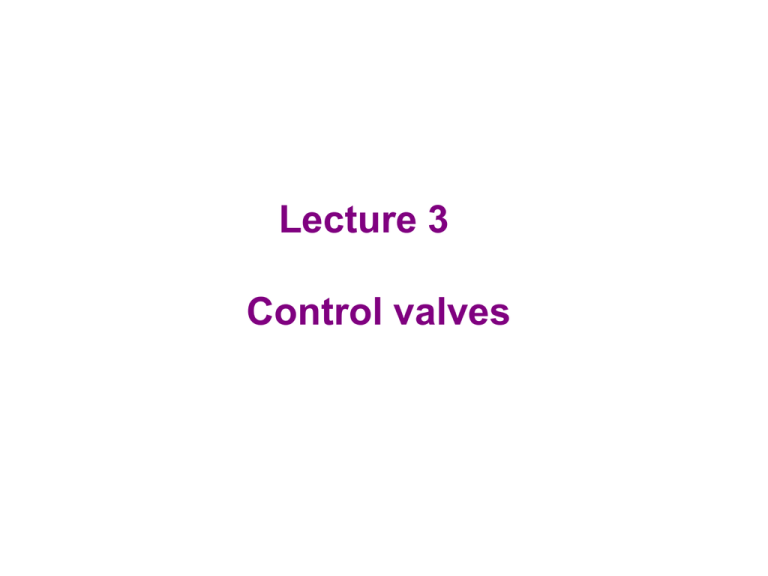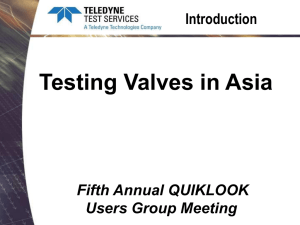control valve
advertisement

Lecture 3 Control valves Elements of the final control Automatic Valve actuator I/P transducer Valve body Current Signal 4-20 ma Flapper Nozzle Back pressure Pneumatic Signal 3-15 psi Diaphragm control valves Globe valve Rotary valve Rotary valve Globe valve Most common control valve style Can be single- or doubleseated Single-seated valves • Usually are employed when – Tight shut-off is required, – In sizes of 1 inch or smaller where unbalance forces acting on the valve stem is unimportant. • Usually have a top guided construction Double-seated valves • Usually is top and bottom guided. • Practical leakage approaches 0.5% of the rated CV. • Advantage lies in reduction of required actuator forces. • Have upper and lower ports of different diameters---allow to withdraw smaller plug through the larger port. Angle valve • Single seated valves with special body configuration to suit specific piping or flow measurements. • May be used in case where the piping layout does not allow installing a globe valve. Three way valves • A design extension of a typical doubleseated valve. • Can be used for diverting service and for mixing service. Actuators for control valves: • Pneumatically operated diaphragm actuators; • Piston actuators; • Electro-hydraulic actuators; • Electro-mechanical actuators; More than 90% in use are pneumatically operated piston or diaphragm type Safety consideration • Air-to-open (AO) Failure close • Air-to-close (AC) Failure open Loss F 1 1 m 2 ; q C1Fa2 2 g ( H1 H 2 ) q C2 Favc 2 g ( H1 H vc ) H1 H vc avc C3 F 2 g ao ( H1 H 2 ) H1 H 2 ao avc Cv ( H1 H 2 ) Cv A( x) ( H1 H 2 ) ao Cv A( x) Pv Gf Defined at maximum Valve opening Related to valve inherent characteristics Over sized plug to provide Additional Cv Special seat machined Into the body Linear valves: A (X) =X= x/xo Equal percentage valves: A (X) = e k(x/xo-1) = a (X-1) Rangeability Equal Percentage Valve q CV a ( x ) pv dq d a( x) CV pv a CV a ( x) pv dx dx d a( x) a ( x) ; a( x) ke x dx a (0) ao k a ( x* ) ao e x * a( x) x ( x x* ) x* ( x / x* 1) a ( X 1) e e e ; X 0 ~1 * * a( x ) x a( x) q a ( X 1) e a ( x* ) Q q when X 0, q qo e a o Q Q a or , e R a ln R qo Equal Percentage Valve q CV a ( x ) pv dq d a( x) CV pv CV a ( x) pv dx dx d a( x) a ( x) ; a( x) ke x dx a (0) ao k a ( x* ) ao e x * a( x) x ( x x* ) x* ( x / x* 1) a ( X 1) e e e ; X 0 ~1 * * a( x ) x a( x) q a ( X 1) e a ( x* ) Q q when X 0, q qo e a o Q Q a or , e R a ln R qo q 2G f PV q CV A( X ) PV 2 Gf CV A( X ) Pf k f q G f 2 P max f k f Q G f k f C PV k f C Pt (1 )Pt 2 2 V PV 2 V kf at q Q Pt 1 1 CV 1 Gf 2 Pf k f q G f q 2 CV 2 2 1 Gf 2 Pf k f q q 2 CV 2 2 1 Gf q Pt 2 2 CV A ( X ) CV2 G f q2 1 2 2 2 1 A ( X ) CV A ( X ) G f q2 Distortion after installation q CV A( X ) 1 2 1 A (X ) Pt Gf q CV A( X ) 1 2 1 A (X ) Pt Gf (1 ) A2 ( x) 1 k f CV2 A2 ( X ) Pt Gf Pt Pt 1 CV Gf Gf 1 k f CV2 Pt Gf CV Q CV 1 q CV Q 1 1 Pt Gf A( X ) (1 ) A2 ( X ) A( X ) A( X ) 1 k f C 2 V 1 k f CV2 A2 ( X ) Valve hysteresis Valve positioner What accomplishment a positioner can have? • Provide precise positioning of the valve • Provide adequate power on high-pressure applications • Increase control valve speed of response • Reverse valve action • Provide split range operation Typical positioner performance • Pneumatic signal ranges: 3-9, 3-15, 9-15, 3-27, 6-30 psig • Air supply pressure: 20 to 100 psig • Repeatability: within 0.1% of stroke • Hysteresis: within 0.3% of stroke • Linearity: 0.5% of stroke Split range control valves Control valve sizing Given expected pressure conditions, select throttling control valve to pass the required flow rate. It is a key step In ensuring that the process can be properly Controlled. Basic sizing practices have been standardized Upon (e.g., ISA S75.01) and are implemented as PC-based program by manufactures. Allocating pressure Drop • The value of is important to the installed valve characteristic curve • The pressure drop is an economic loss to the process operation • Low pressure drop result in larger valve sizes and in decrease in a range of control • Rules of thumb: “20% to 50% of total dynamic pressure drop”, or, “25% or 10 psi” Determine valve capacity to meet required flow rate--- Computing CV For liquid service: q CV Pv q : GPM Gf W CV ; 500 G f PV W : lbm / hr For gas and vapor: CV q G f T (o F ) 836C f P1 ( y 0.148 y ) 3 , W CV , 3 2.8C f P1 G f ( y 0.148 y ) flow by volumn flow by weight For steam: CV y= W (1 0.0007TSH ) , 3 1.83C f P1 ( y 0.148 y ) 1.63 P/P1 Cf Cf: critical flow factor Tf: degree of superheat in oF P1:upstream pressure Gf: specific gravity at 14.7psi and 60oF There are still many other formulas in Provided by control valve manufacturers. The formulas have different forms but give similar results. To meet working flexibility, CV, PV and Pt are to satisfy the following: Q qmax CV 2 Q Pt Pf 2 q q0 qmin CV f ( X min) Q2 Pt Pf 2 q Pt qo2 Pt Pf 2 q Q qmax CV q0 qmin 2 Q2 Q Pt 1 2 PV 2 q q 2 o 2 2 o 2 q q CV f ( X min ) Pt (1 ) PV q q Given either three of the following five variables ( Q ,qo, CV, Pt , PV ), the other two can be Computed. Rangeability of a control valve: Q Rangeability , qo when PV is a constant After being installed: Q Turn down ratio , qo when Pt is a constant There are standard procedures to size a control valves, besides computing CV. In most sizing problem, the size of pipe is Known. It is usually to solve for CV and reducers combined. Thus, a geometric factor, Fp, is required in the flow formula: q FPCV P Gf The details are out of the scope of this lecture. To select an equal percentage valve: Pv 0.333Pf • Select • Calculate Cv , the value yields at least 100% of qd with the available pressure drop. • Compute q as a function of valve position using the rated Cv and Pv. The valve characteristics should be reasonablly linear in the operation range of interest. • If not suitably linear, adjust the rated Cv phe q ; 30 200 2 q Phe 30 200 q Pv 40 Phe 40 30 200 At design flow rate, qd : Pv / Phe 10/30 33.3% Cv 200 126.5 0.5 10 2 2 CV 220 40 30 1.12 Use CV 115, 114.4 q q l 1 R l 1 log CV PV CV PV log R






